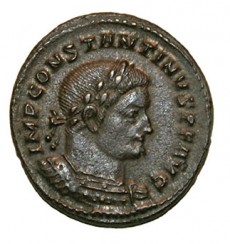 Humanities
Humanities
Coin of the realm

In the ancient city of Sardis, in what is now Turkey, an excavated temple dedicated to Artemis was found to have an inscription on the side — but it had little to do with worshipping the Greek goddess of the hunt.
Instead, the inscription documents an economic transaction: The priests and priestesses of the temple had foreclosed on the estate of an individual who owed the temple money.
Debt, in other words, is as old as civilization itself. “Even then,” said Noah Kaye, visiting assistant professor of classics, “people were getting in over their heads.”
Money lending — along with other economic systems such as taxation and global trade — are at the heart of a new classics course Kaye is teaching this winter, Archaeology of Ancient Economy. It seeks to answer the question: Since when has money made the world go ’round?
Kaye, an archaeologist, is especially interested in the ways that inscriptions, coins, weights and measures illuminate the history of early Roman, Greek and Middle Eastern societies. The Sardis inscription, for instance, reveals the fact that temples were a primary hub of economic activity.
Temples lent money, charged interest and collected on debts, relying on a higher power (the god or goddess to whom the temple was dedicated) to enforce compliance. “Divine wrath was an effective form of security,” said Kaye.
“They were the biggest banks,” he said. “And they were too big to fail—perish the thought that Artemis should not have her gold and ivory treasury.”
Coins and inscriptions similarly speak volumes about economic life in ancient times. Tablets and stones from excavated sites have been found with inscriptions of merchant inventories, trade transactions and debt payments.
Coins can demonstrate how integrated and cohesive an economic system — and the society at large — may have been. The Romans, for instance, had one system of coins for the entire realm, underscoring the top-down control of the Roman Empire. The Greek city-states each had their own coinage, consistent with the concept of early democracy.
Weights and measures demonstrate the existence of regulated markets, where a trader could have greater assurance of getting a fair deal because of a uniform and enforceable system of measurement.
All of this is fertile ground for exploration, said Kaye, because much of the existing body of research and scholarship about these ancient societies has focused on philosophers, military leaders, poets and mythologies of the times.
In delving into the everyday hurly-burly of the marketplace and financial transactions, “we are dealing with a very nonelite segment of society,” he said. “It is not as well studied.”
Besides guiding his students toward an understanding of how our current economic system came to be, Kaye hopes his course will also illuminate alternatives.
“These were complex economies run by a different logic,” he said. “Our way is not the only way things can be.”
—Lisa Raleigh


 Twitter
Twitter Facebook
Facebook Forward
Forward